Cooking
Haunted House Gingerbread
Assemble a spooky haunted house gingerbread treat and uncover the fascinating history behind this beloved holiday craft, but be prepared to resist the temptation to devour your edible creation.

Unleash your inner Halloween spirit by crafting a spooky haunted house gingerbread! This beloved holiday treat has ancient roots, with the Middle Ages seeing the incorporation of distinctive ginger flavor. Today, you'll knead rich, molasses-infused dough, roll out shapes, and bake sturdy gingerbread pieces. Decorate with royal icing and candies to create a visually striking dessert that captivates attention. Let your imagination soar as you experiment with unique designs and personalize your haunted creation. Display your masterpiece with pride, then slice into the delicious flavors – but be warned, you may not want to destroy this edible work of art! There's more to uncover about the history and craft of haunted house gingerbread.
Key Takeaways
- Gingerbread can be crafted into haunted house designs, incorporating spooky elements and unique shapes to create visually striking holiday desserts.
- Decorating gingerbread houses with royal icing and candies allows for personalization and the incorporation of a haunted aesthetic.
- Baking gingerbread components and assembling the haunted house can become a family-bonding experience, fostering creativity and lasting memories.
- Displaying the completed haunted gingerbread house as a centerpiece during holiday gatherings creates a captivating focal point.
- Enjoying the delicious flavors of the gingerbread house, despite hesitation to destroy the intricate design, is a rewarding part of the experience.
History
Gingerbread's origins can be traced back to ancient Egypt, where honey-sweetened breads were baked in intricate shapes. Over time, this delectable tradition spread throughout Europe, evolving into the beloved gingerbread we know and love today.
In the Middle Ages, European bakers experimented with spices, eventually incorporating the distinctive ginger flavor that became a hallmark of gingerbread. As gingerbread grew in popularity, it took on various forms, from simple cookies to elaborate house-shaped creations.
The tradition of shaping gingerbread into whimsical structures gained particular traction in Germany, where families would craft detailed gingerbread houses during the holiday season. These enchanting edible structures inspired the iconic gingerbread houses that have become a staple of modern Christmas celebrations.
Additionally, much like how regional water parks contribute to local economies, gingerbread houses bring communities together through festive baking events and competitions.
Today, gingerbread's timeless charm continues to captivate bakers and enthusiasts alike, with endless opportunities to create unique and festive designs, from haunted houses to charming cottages. The history of this beloved treat is a testament to the enduring power of culinary innovation and the joy of sharing homemade delights.
Recipe
Gingerbread has long been a beloved holiday treat, evoking the warmth and spice of the season. This haunted house version takes the traditional recipe and transforms it into a whimsical and spooky centerpiece for your Halloween celebrations.
The rich, molasses-infused dough and intricate decorations create a delightfully eerie confection that's sure to delight both young and old. To make your Halloween even more enjoyable, consider pairing your gingerbread creation with activities like setting up a portable camping toilet for added convenience during outdoor festivities.
Preparing this haunted house gingerbread requires a bit of patience and attention to detail, but the end result is well worth the effort. The process of constructing the house and adorning it with ghoulish details is a fun activity the whole family can enjoy, making memories that will last long after the last crumb has been devoured.
Cooking Steps
First, knead the dough on a floured surface until it's smooth and pliable.
To add some festive flair, consider using colorful sprinkles to mimic the look of Cotton Candy Ice Cream.
Next, roll out the dough to a 1/4-inch thickness, then use cookie cutters to cut out your haunted house shapes.
Step 1. Knead Dough on Floured Surface
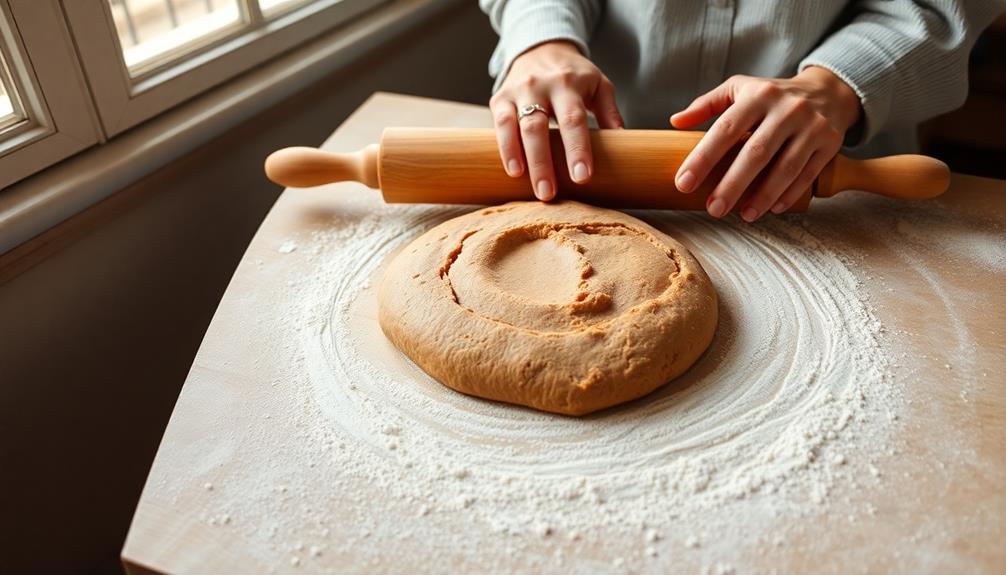
To begin, knead the dough on a lightly floured surface. Use the heel of your hand to push the dough away from you, then fold it back toward you. Rotate the dough and repeat this process for 2-3 minutes until the dough becomes smooth and elastic.
Don't be afraid to add more flour if the dough starts to stick to the surface. The texture of the dough should be soft yet firm, similar to the comfort of modern farmhouse textiles that add warmth to a space.
Once the dough is nicely kneaded, it's time to roll it out. Lightly flour the surface again and use a rolling pin to gently roll the dough out to your desired thickness, about 1/4 inch.
Be careful not to overwork the dough, as this can make it tough. Use cookie cutters to cut out your haunted house shapes, transferring them to a parchment-lined baking sheet as you go.
Gather any scraps, re-roll, and cut out more shapes until you've used all the dough. Now you're ready to bake your haunted gingerbread houses!
Step 2. Roll Out Dough to 1/4-Inch Thickness

Once you've kneaded the dough to the desired texture, it's time to roll it out. Dust your work surface generously with flour to prevent the dough from sticking. Gently press the dough into a rough rectangle shape with your hands.
Using a rolling pin, start rolling the dough from the center outward, applying even pressure. Rolling out dough to 1/4-inch thickness is essential for achieving the right texture in your numerous varieties of gingerbread cookies. Roll the dough until it's approximately 1/4-inch thick, turning it occasionally to ensure an even thickness.
Be mindful of the edges, rolling them just as much as the center to maintain a level surface. If the dough starts to stick, simply dust the surface and your rolling pin with a bit more flour.
Once you've achieved the desired thickness, use a bench scraper or sharp knife to trim the edges, creating clean, straight sides. This step ensures your gingerbread house pieces will fit together neatly.
With the dough rolled out, you're now ready to begin cutting out the various shapes needed for your haunted house design.
Step 3. Cut Out House Shapes

With the dough rolled out to the perfect 1/4-inch thickness, you can now start cutting out the various house shapes for your haunted gingerbread creation.
Grab your favorite cookie cutters and let your imagination run wild. You can create a traditional gingerbread house, complete with walls, a roof, and a chimney, or get creative with spookier shapes like haunted mansions, creepy cottages, or even a gingerbread graveyard.
Don't be afraid to experiment – the more unique your shapes, the more character your haunted house will have.
Carefully transfer each cut-out shape onto a parchment-lined baking sheet, ensuring they're evenly spaced. This will make the assembly process much easier later on.
Remember to re-roll any dough scraps and continue cutting out shapes until you've used up all the dough.
With your house pieces ready, you're one step closer to bringing your haunted gingerbread vision to life.
Step 4. Bake Gingerbread House Pieces

Preheat your oven to 350°F (175°C). Time to bake the gingerbread pieces for your haunted house!
First, roll out your dough to about 1/4-inch thickness on a lightly floured surface. Use your pre-made house templates to carefully cut out the walls, roof, and any other shapes you'll need. Transfer the pieces to a parchment-lined baking sheet, making sure they're spaced apart.
Bake the pieces for 12-15 minutes, or until they're golden brown and firm to the touch. Keep a close eye to prevent over-baking, which can make the gingerbread brittle.
Once done, let the pieces cool completely on the baking sheet before handling. Trim any rough edges or imperfections with a sharp knife.
Now you've got the sturdy, flavorful foundations for your haunted gingerbread house. Time to start assembling!
Step 5. Decorate With Royal Icing and Candies

Now that you have your sturdy gingerbread pieces, it's time to bring your haunted house to life with royal icing and candies.
Start by preparing your royal icing. Mix the powdered sugar, egg whites, and a splash of vanilla extract until you have a smooth, spreadable consistency. This will act as the "glue" to hold your gingerbread pieces together and decorate the house.
Next, it's time to get creative with your candy decorations. Licorice strips can make eerie window frames, while gumdrops and jellybeans can become colorful shingles or spooky accents.
Crushed cookies or graham crackers can be scattered around the base to create a "spooky" graveyard. Be sure to use your royal icing to "glue" the candies in place, creating a haunting masterpiece. For an added touch, consider using candy eyes or other ghoulish decorations to bring your haunted snack to life. If you really want to go all out, try incorporating some edible food coloring to give your graveyard a touch of “blood” or other eerie hues. This spooky breakfast recipe is sure to be a hit at any Halloween gathering and is a fun activity to do with kids.
Don't be afraid to experiment and have fun with your design. The more unique and imaginative your touches, the more your haunted gingerbread house will stand out.
Let your creativity shine through and enjoy the process of bringing your haunted creation to life.
Final Thoughts
As you put the final touches on your haunted house gingerbread creation, take a moment to step back and admire your handiwork.
You've transformed a simple gingerbread structure into a spooky masterpiece, complete with intricate details and a haunting atmosphere. The combination of royal icing and candies has brought your vision to life, creating a truly impressive and visually striking dessert.
Now that your haunted house is complete, consider displaying it as a centerpiece for your holiday gatherings. Its eye-catching design is sure to impress family and friends, and they'll be amazed by the time and effort you've put into crafting this edible work of art.
Don't be surprised if they're hesitant to take a bite, as it may be too beautiful to destroy! When you're ready, carefully slice into the gingerbread and enjoy the delicious flavors that have been infused into every element of your haunted creation.
Frequently Asked Questions
How Long Will the Gingerbread House Last Before Going Stale?
Your homemade gingerbread creation can stay fresh for quite a while with proper storage.
Typically, a gingerbread house will last 2-4 weeks before going stale, depending on the ingredients and how it's kept.
Store it in an airtight container at room temperature, away from direct sunlight or heat.
With a little care, you can enjoy your festive gingerbread for several weeks and impress your guests with your baking skills.
Can the Gingerbread House Be Used as a Decoration Year-Round?
A gingerbread house can absolutely be used as year-round decor!
While it may not stay fresh indefinitely, you can display it proudly for several months before it starts to go stale.
Just keep it in a cool, dry place and avoid handling it too much.
With a little creativity, you can even transform your gingerbread house into a unique piece of art that adds charm to your home all year long.
What Type of Ghosts or Spirits Might Haunt the Gingerbread House?
The gingerbread house could be haunted by a variety of ghostly inhabitants.
Perhaps a mischievous poltergeist who enjoys rearranging the candy décor or a mysterious spirit who leaves behind ectoplasmic crumbs.
You might even spot a friendly ghoul munching on a gingerbread man!
These paranormal guests could add an extra touch of whimsy and wonder to your home, though they might also require some creative problem-solving to keep them from disrupting your holiday cheer.
Can the Gingerbread House Be Displayed Outdoors in Warm Weather?
Displaying your gingerbread house outdoors in warm weather isn't recommended. The heat and humidity can quickly soften the dough, causing it to warp and collapse.
Even if you coat it with a protective sealant, the sun's rays will eventually disintegrate the intricate details.
For best results, keep your gingerbread creation indoors in a cool, dry environment.
With proper storage, you can enjoy its spooky charm for weeks to come!
How Do I Prevent the Gingerbread House From Collapsing?
To prevent your gingerbread house from collapsing, start by using a sturdy base, like a thick cardboard or plywood.
Reinforce the structure with internal supports, like dowels or skewers, to provide stability.
Apply a generous amount of royal icing between the panels to create a strong bond.
Let the icing dry completely before adding any decorations.
Finally, handle the house carefully and avoid placing too much weight on top.
With these tips, your gingerbread creation will stand tall and proud.
Cooking
Why Some Cultures Embrace Bitter Flavors More Than Others
Diving into the reasons behind cultural preferences for bitterness reveals intriguing health benefits and evolving taste trends—what factors shape your own palate?
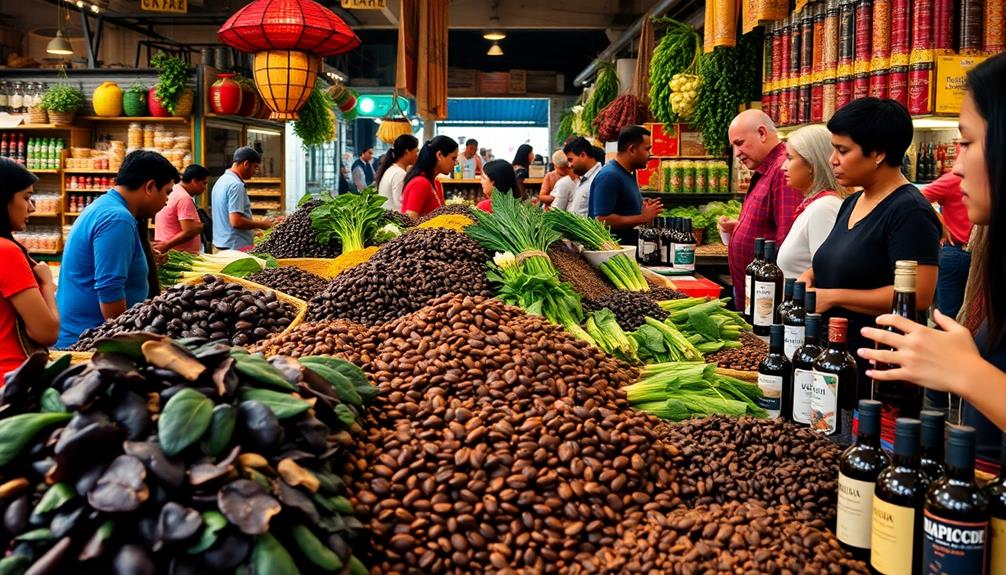
Cultures embrace bitter flavors differently due to historical, health, and genetic factors. For instance, many Asian cuisines celebrate bitterness for its health benefits, using ingredients like bitter melon for blood sugar control. In contrast, American tastes traditionally lean towards sweet, although that's changing with the rise of craft beer. Genetic sensitivity also plays a role; some populations find bitter tastes more pronounced than others. As you explore these factors, you'll uncover how culinary traditions and modern trends evolve, influencing your own taste preferences.
Key Takeaways
- Cultural attitudes toward bitterness vary, with some cuisines linking it to health benefits and incorporating it into traditional dishes.
- Agricultural practices and historical food scarcity shaped acceptance of bitter flavors in certain regions, influencing culinary traditions.
- Genetic sensitivity to bitter tastes affects individual preferences, with variations in the TAS2R38 gene contributing to cultural differences in food enjoyment.
- The growing awareness of health benefits associated with bitter foods is shifting consumer preferences, leading to increased acceptance and experimentation with bitterness.
- Culinary innovations, such as craft cocktails and modern gastronomy, are popularizing bitter flavors, reflecting changing trends in food consumption.
Cultural Attitudes Toward Bitterness

Culinary landscapes around the world reveal striking differences in how cultures embrace bitterness. Your cultural attitudes toward bitter flavors directly shape your culinary experiences.
For instance, in Chinese cuisine, bitterness is often linked to health benefits, with ingredients like bitter melon frequently appearing in stir-fries and soups. These dishes not only highlight the health aspect but also showcase the sophistication of Chinese culinary traditions.
Similarly, Indian cuisine features a variety of flavors, including bitter elements found in certain dishes like Mushroom Masala, which can be complemented by the richness of spices that enhance overall flavor profiles.
On the other hand, Italian cuisine exemplifies a refined palate that balances bitter ingredients, like radicchio, with sweetness, revealing a deep appreciation for complexity in flavors. This acceptance of bitterness creates a unique dining experience.
In contrast, American cuisine generally steers clear of bitter flavors, although trends are shifting. The craft beer industry and cocktails like Negronis are starting to challenge this avoidance, inviting a broader acceptance of bitterness.
Social factors and early exposure to bitter foods in childhood play critical roles in developing your taste preferences. Those who grow up with bitter flavors often develop a greater tolerance and appreciation for them as adults, illustrating how cultural attitudes and culinary traditions intertwine to shape your palate.
Historical Influences on Flavor Preferences
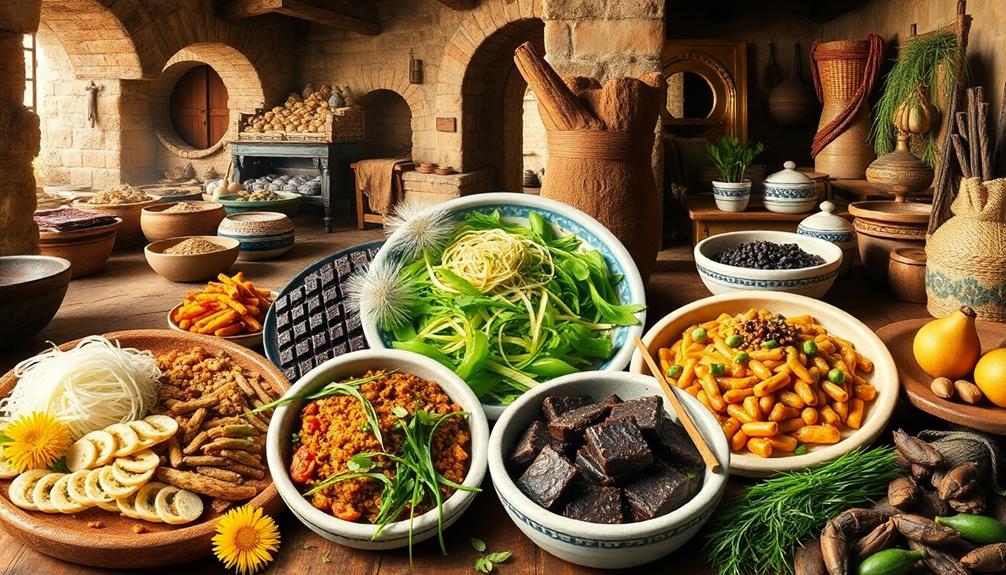
Your taste preferences are often rooted in historical influences that have shaped how different cultures perceive flavors, particularly bitterness. Regions that cultivated bitter crops, like bitter melon in China, developed a cultural acceptance of these flavors due to their availability and recognized health benefits.
Similarly, bitter dishes like Muamba De Galinha from Angola showcase how local ingredients can shape flavor profiles that become central to cultural identity.
Several factors contribute to this trend:
- Historical agricultural practices that prioritized bitter plants.
- Cultural significance tied to the medicinal properties of bitter foods, especially in traditional diets.
- Culinary practices influenced by ancient trade routes, which facilitated the exchange of bitter ingredients.
- Societal norms that emerged during periods of food scarcity, promoting bitter flavors when sweet options were limited.
These influences have created a rich tapestry of flavor preferences that persist today. In many cultures, bitter flavors aren't just about taste; they carry historical weight and convey nutritional value.
As societies evolved, narratives surrounding the health benefits of bitter foods reinforced their role in diets, particularly in Mediterranean and Asian cuisines that emphasize balance and nutritional intake. Understanding these historical influences helps you appreciate the complexity behind your flavor preferences.
Health Benefits of Bitter Foods
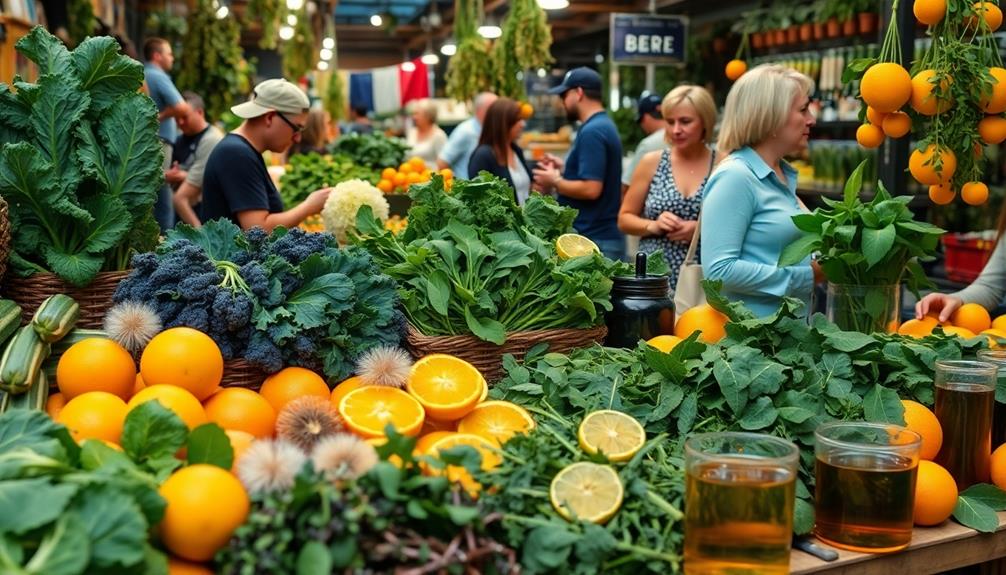
Bitter foods pack a powerful punch when it comes to health benefits. Incorporating these flavors into your diet can greatly impact your overall health and well-being. They're known to enhance immune system function and may even help prevent certain types of cancer, thanks to their rich antioxidant content. Furthermore, bitter foods stimulate digestion by promoting the production of digestive juices, which aids nutrient absorption.
| Health Benefits | Description |
|---|---|
| Immune System Support | Enhances immune function and may prevent cancer |
| Improved Digestion | Stimulates digestive juices for better nutrient absorption |
| Blood Sugar Regulation | Helps regulate blood sugar levels and reduces cravings |
| Liver Function & Detoxification | Supports liver health and detox processes |
Regularly consuming bitter foods can help manage weight by promoting satiety, reducing cravings for sweet and processed options. This encourages healthier dietary choices and increases diversity in your meals. By embracing bitter flavors, you're not just savoring unique tastes; you're also investing in your health.
The Role of Genetics in Taste

Taste perception is profoundly influenced by genetics, with variations in the TAS2R38 gene playing an essential role in how people experience bitter flavors. Your sensitivity to bitterness is shaped by genetic variations that impact the bitter taste receptors, leading to different dietary preferences across cultures.
For instance, in Brazilian cuisine, the use of diverse ingredients, including spices and herbs, reflects these genetic influences on taste preferences. This can be seen in traditional dishes like Caruru, which often feature bold flavors that some may find bitter while others savor.
Consider these key points about the role of genetics in taste:
- Approximately 25 TAS2R genes are responsible for unique bitter taste receptors.
- Studies show that populations in Africa usually have a higher sensitivity to bitterness compared to Europeans.
- Certain allelic variations in taste receptor genes can predict how you'll react to bitter compounds.
- Genetic predispositions toward bitterness can explain cultural differences in food enjoyment.
These genetic factors influence not just your personal taste but also broader cultural attitudes towards bitter flavors. Some cultures embrace these tastes, incorporating them into their cuisines, while others may shy away from them.
Understanding how the TAS2R38 gene affects your sensitivity to bitterness can provide insight into your own dietary preferences and the diverse ways different populations enjoy their food.
Culinary Uses of Bitter Ingredients

When you explore culinary uses of bitter ingredients, you'll notice how different cultures embrace these flavors.
For instance, in Chinese cuisine, the unique taste of chicken feet often incorporates bitter elements through the use of certain spices and sauces, enhancing the dish's complexity.
From the health benefits of bitter melon in Chinese stir-fries to the sophisticated touch of radicchio in Italian salads, bitterness plays a key role in flavor balancing.
Plus, with its presence in craft beer and social beverages like yerba mate, bitterness is more than just a taste—it's a cultural experience.
Cultural Ingredient Preferences
Embracing the unique qualities of bitter ingredients, various cultures around the world incorporate these flavors into their culinary traditions. You'll find that each culture's ingredient preferences reflect their appreciation for bitterness and its accompanying health benefits.
For instance, many cuisines also utilize fresh greens that offer a balance of flavors, similar to how Nettle and Potato Soup combines nutritious ingredients for a wholesome dish. Here are some notable examples:
- Chinese cuisine: Bitter melon is a staple, often found in stir-fries and soups, celebrated for its blood sugar-regulating properties.
- Italian cuisine: Radicchio adds a bitter touch to salads and desserts, showcasing the balance of bitter flavors with sweetness.
- Mediterranean diets: Bitter greens like arugula and dandelion enhance salads and stews, promoting both flavor complexity and health benefits.
- Latin American cultures: Traditional beverages like yerba mate embrace bitterness, providing stimulating effects alongside health properties.
These culinary practices reveal how cultures embrace bitter flavors, integrating them into their daily foods.
Flavor Balancing Techniques
Bitter ingredients can add depth and complexity to your dishes, but balancing their intensity is key to creating a harmonious flavor experience. To achieve this, you should pair bitterness with sweet ingredients like honey or sugar. This can counteract the sharpness and create a delightful flavor profile. For example, just like the sweetness of the red bean paste in Dorayaki helps to balance the flavors, sweet ingredients can enhance your dishes.
Additionally, incorporating acidity from lemon juice or vinegar can effectively cut through bitterness, enhancing the dish's overall freshness. You can also utilize cooking techniques such as roasting or grilling, which mellow the bitterness of vegetables, making them more palatable while introducing complex flavors.
Don't forget the power of creamy elements! Adding dressings or sauces alongside bitter greens can provide a rich contrast that elevates your meal's experience.
During meal preparation, it's crucial to experiment with these various components. Frequent taste testing helps you find the right ratios and combinations to achieve an ideal balance of bitterness.
Health Benefits of Bitterness
Incorporating bitter ingredients into your meals not only enhances flavor but also brings a range of health benefits. The health benefits of bitterness are substantial, particularly concerning digestive health and liver function. By including bitter foods like dandelion greens and Brussels sprouts, you can support your body's detoxification processes.
Additionally, many cuisines, such as Lebanese, often pair bitter greens with rich flavors, enhancing overall meal enjoyment, similar to how Kawarma (Preserved Meat) complements a variety of dishes.
Here are some key advantages of adding these versatile ingredients to your diet:
- Improved bowel function: Bitter foods can help regulate digestion and alleviate issues like acid indigestion.
- Enhanced liver function: These foods promote detoxification, essential for overall health.
- Rich in antioxidants: Greens such as arugula and kale are packed with nutrients that contribute to skin health and combat oxidative stress.
- Potential to reduce reliance on medications: The "Food as Medicine" movement highlights how bitter ingredients can play a role in managing health issues naturally.
Many traditional cuisines embrace bitterness, incorporating these ingredients in salads, soups, and beverages. By making these culinary choices, you not only enjoy unique flavors but also invest in your well-being.
Shifting Trends in Food Consumption
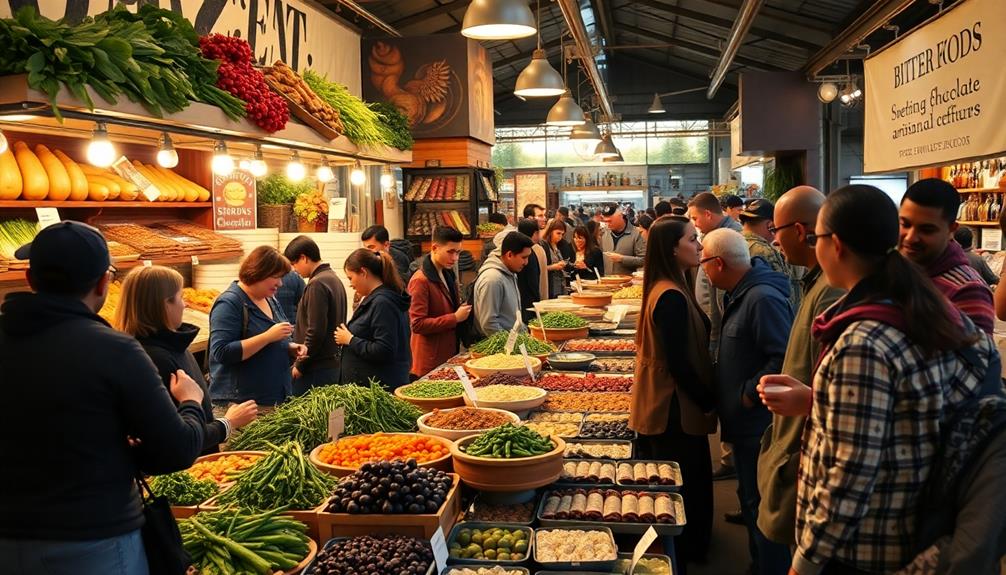
As you explore the shifting trends in food consumption, you'll notice a growing cultural acceptance of bitter flavors. This change is fueled by an increasing awareness of health benefits and innovative culinary techniques that highlight these unique tastes.
For instance, traditional Ethiopian beverages like Tella offer a slightly sour yet complex flavor profile that reflects this trend. You'll find that more people are embracing bitterness, making it an exciting time for adventurous eaters.
Cultural Preferences and Beliefs
Cultural preferences shape how we experience and enjoy flavors, and bitter ones are no exception. Different culinary traditions influence what people embrace and reject. While many Western cuisines lean towards sweetness, others find value in bitterness. For instance, Italian cuisine celebrates the complexity of bitter ingredients like radicchio, showcasing a balance of flavors rather than avoidance.
In Korean cuisine, dishes like kimchi, which can have a slight bitterness depending on fermentation, reflect a broader acceptance of diverse flavor profiles, emphasizing the importance of balance in meals through various side dishes and main courses like bulgogi.
Consider these aspects that illustrate this cultural divergence:
- Chinese cuisine often incorporates bitter melon, highlighting its health benefits.
- Latin American cultures enjoy yerba mate, reflecting a long-standing appreciation for bitter profiles.
- The rise of craft beer and bitter cocktails in the U.S. indicates shifting consumer preferences.
- The "Food as Medicine" movement is encouraging Western consumers to embrace bitter flavors for improved digestion.
As you explore these culinary practices, you'll notice that bitterness isn't just a flavor; it's a reflection of cultural beliefs and health philosophies.
This gradual acceptance of bitter flavors in various cultures demonstrates how food can evolve with consumer preferences, blending tradition with modern insights into nutrition.
Health Benefits of Bitterness
Embracing bitter flavors can reveal a wealth of health benefits that many consumers are just beginning to appreciate. Bitter foods like kale and dandelion greens are packed with antioxidants that support liver function and enhance digestion.
Additionally, incorporating ingredients from diverse cuisines—such as the use of herbs in dishes like Nasi Tumpeng can enhance flavor while providing nutritional benefits. Incorporating these vegetables into your meals not only adds a unique flavor but also aids in detoxification and acts as a gentle diuretic.
As awareness of high salt intake risks grows, bitter flavors serve as a flavorful alternative to salty foods. By choosing these bitter options, you can lower your blood pressure while boosting your overall health.
Curiously, studies suggest that consuming these flavors may help reduce cravings for sweet and processed foods, promoting healthier eating habits and effective weight management.
This shift towards bitter ingredients in culinary practices reflects the growing "Food as Medicine" movement, emphasizing the importance of dietary balance for overall well-being.
Culinary Innovations and Trends
Bitter flavors are making waves in the culinary world, thanks to a growing interest in innovative cooking and the farm-to-table movement. This shift is appealing to adventurous eaters who crave depth in their meals.
Cultural differences play a significant role in how these flavors are embraced, with various cuisines highlighting bitter as a crucial component.
You might notice several trends emerging from this culinary evolution:
- Increased use of bitter greens and vegetables in modern recipes
- Innovative cooking techniques like charring and high-heat methods to enhance bitterness
- The rise of craft cocktails, showcasing bitter ingredients in drinks like Negronis and Old Fashioneds
- Online platforms where chefs experiment with balanced dishes that highlight unique flavor profiles
As you explore these trends, you'll find that bitter flavors are no longer just an afterthought.
Instead, they're becoming a centerpiece in many dishes, challenging traditional food preferences and inviting you to rethink your palate.
With chefs and home cooks pushing boundaries, the culinary landscape is evolving, making bitterness a celebrated aspect of modern gastronomy.
Frequently Asked Questions
Why Do Some People Like Bitter Flavours?
You might like bitter flavors because they offer complexity and depth in taste. Your experiences with food, genetic sensitivity, and awareness of health benefits can all shape your appreciation for these unique and often intriguing flavors.
Why Do Some People Taste Bitter More Than Others?
Your taste for bitterness varies due to genetic factors, particularly the TAS2R38 gene. This genetic variation influences how sensitive you are to bitter compounds, shaping your food preferences and experiences throughout your life.
Are People Who Are Genetically More Sensitive to Bitter Tastes?
You're absolutely right! People who are genetically more sensitive to bitter tastes often find themselves in a flavor battlefield, retreating from foods like kale and coffee while others dive joyfully into those bitter delights.
Why Is It Important That We Have a Bitter Taste?
Having a bitter taste is vital for your safety; it helps you detect potentially harmful substances. Additionally, it supports digestion, encourages healthier eating habits, and provides essential nutrients that contribute to overall wellness.
Conclusion
In exploring why some cultures embrace bitter flavors more than others, it's clear that historical influences, health benefits, and even genetics play significant roles. The theory that exposure shapes taste preferences holds true; cultures with long histories of consuming bitter foods often appreciate them more. As culinary trends shift, you might find yourself drawn to these flavors, discovering their complexity and richness. Embracing bitterness could not only expand your palate but also enhance your overall well-being.
Cooking
The Psychology of Competitive Eating and Its Cultural Significance
Delve into the intriguing world of competitive eating, where psychology meets cultural fascination—discover what drives this phenomenon and its deeper implications.

Competitive eating isn't just an odd show; it taps into psychological drivers and cultural themes. You'll see how it reflects society's obsession with abundance and consumerism. Famous events like Nathan's Hot Dog Contest highlight this spectacle, drawing massive crowds and media attention. Competitors, like Joey Chestnut, push their limits, converting food into a competitive challenge. Yet, health risks loom in the background, raising ethical questions about sustainability and food waste. Understanding these elements reveals more than what's on the plate—it's about what it signifies in our culture. There's plenty more to explore about this fascinating trend.
Key Takeaways
- Competitive eating reflects American consumerism, showcasing society's fascination with abundance and excess during events like Nathan's Hot Dog Contest.
- The sport's evolution from informal contests to organized events highlights individual performance and the celebration of remarkable achievements.
- Media portrayal of competitive eaters as "Celebrity Consumers" reinforces cultural values of indulgence, increasing public interest and participation in these events.
- Gender dynamics influence consumption behavior, with male competitors consuming more food due to social encouragement, while females face self-consciousness and societal pressures.
- Ethical concerns arise regarding food waste and health risks, prompting discussions on responsible consumption and the long-term nutritional impact of competitive eating.
Origins of Competitive Eating

Emerging in Japan during the 1990s, competitive eating began to gain traction alongside the popularity of cooking shows like *Iron Chef*. This burgeoning sport found its way to America and connected deeply with traditional American culture, particularly through events like the Nathan's Famous Hot Dog Contest.
Starting as a local event in 1916, the contest gained national recognition in the 1990s, thanks to the promotional efforts of publicists George and Richard Shea. Notably, food traditions around the world, such as Muamba De Galinha in Angola, highlight the cultural significance of communal eating experiences.
The sport really took off in 2001 when Takeru Kobayashi set a record by consuming 50 hot dogs, creating a buzz that captured public interest. This moment marked a significant turning point, leading to a wave of competitors enthusiastic to challenge that benchmark. Joey Chestnut later surpassed Kobayashi's record by eating 69 hot dogs in 2013, further solidifying competitive eating's place in American culture.
While competitive eating may have evolved from informal contests, its origins are rooted in historical pie-eating contests at American county fairs, dating back to the 17th century.
Today, it stands as an organized sport with formal rules, emphasizing individual performance and record-setting.
Cultural Reflections of Excess
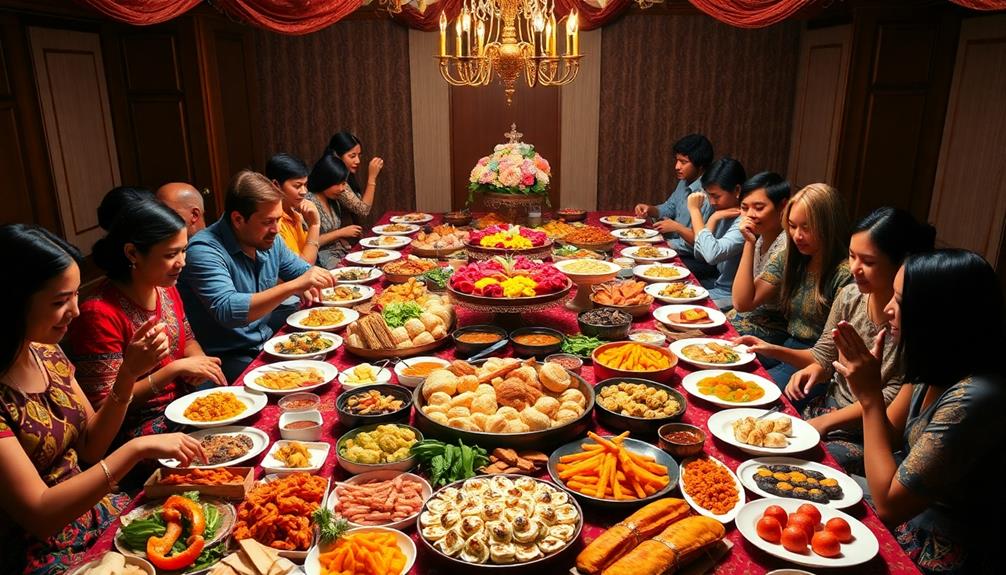
Competitive eating acts as a vivid reflection of American culture, showcasing a fascination with abundance and consumerism. Events like Nathan's Hot Dog Contest draw massive crowds and millions of TV viewers, serving not just as competitions but as spectacles of excess.
In this culinary landscape, you might also find creative food presentations that capture the festive spirit of gatherings, such as Graveyard Taco Dip, which mirrors the playful indulgence of competitive eating. You see, participants often become "Celebrity Consumers," embodying society's celebration of indulgence and overconsumption.
The media coverage surrounding these events, including ESPN broadcasts and documentaries, plays an essential role in shaping how you perceive food consumption. It transforms eating into a thrilling spectacle, reinforcing ideas of excess in popular culture.
Competitive eating isn't merely about food; it's a performance that juxtaposes gluttony with entertainment, challenging traditional food norms. As you engage with this phenomenon, you might notice it reflects broader societal trends towards individualism amid overwhelming consumer forces.
The struggle for identity manifests in the competitive arena, turning consumption into a sport. Ultimately, competitive eating encapsulates the complexities of contemporary consumption patterns, highlighting how society celebrates, critiques, and even commodifies excess.
Profiles of Competitive Eaters

The world of competitive eating features a diverse range of personalities, each with unique backgrounds and strategies that contribute to their success.
Take Joey Chestnut, for example; standing 6 feet tall and weighing 225 pounds, he's the dominant figure in the sport, with over $200,000 in career earnings and a staggering record of 69 hot dogs consumed in 2013. Known for their impressive appetites, competitive eaters often train with various types of cuisine, including dishes like Mushroom Masala, which showcases the rich blend of spices that can enhance one's culinary experience.
Then there's Sonya Thomas, affectionately known as "The Black Widow." Weighing just 100 pounds, she manages a Burger King while holding the women's record with 45 hot dogs.
Takeru Kobayashi, weighing only 105 pounds, revolutionized the game by incorporating weightlifting into his training, leading to a record of 50 hot dogs in 2001.
Additionally, competitors like Jason "Crazy Legs" Conti adopt unique strategies to enhance their performance in eating competitions.
Regardless of their individual approaches, competitive eaters generally view food as an obstacle rather than sustenance, driven by dedication and the desire to achieve remarkable feats in Professional Competitive Eating.
Their diverse backgrounds and strategies make this sport not only fascinating but a demonstration of human determination.
Media Influence and Public Perception

In recent years, media coverage has transformed competitive eating from a niche pastime into a widely recognized spectacle. Major networks like ESPN have vastly increased visibility for events such as Nathan's Hot Dog Contest, attracting millions of viewers and raising public perceptions of this unique sport.
You might notice how competitive eaters are often portrayed as "Celebrity Consumers," reflecting American values of abundance and consumerism. This fascination with excess is echoed in various cultural expressions, such as the rich flavors of Red-Braised Pork Belly, which showcases the importance of indulgence in culinary traditions.
Here are three key points illustrating this media influence:
- Cultural Fascination: Events draw over 40,000 spectators and nearly 2 million television viewers, showcasing society's obsession with excess.
- Patriotic Framing: The portrayal of these contests often evokes a sense of national pride, further influencing public interest and participation.
- Ethical Questions: As competitive eating gains popularity, it raises ethical concerns about food waste and health implications, prompting debate on societal norms regarding consumption.
These dynamics highlight how competitive eating contests not only entertain but also challenge our understanding of food in a consumer-driven society.
Health Risks and Nutrition Concerns

When you participate in competitive eating, you're not just facing a thrilling challenge; you're also exposing yourself to significant short-term health risks like nausea and digestive issues.
The sheer volume of food consumed can lead to immediate discomfort and long-term health consequences. Over time, the extreme consumption can disrupt your nutritional balance and affect your weight management, making it essential to evaluate the importance of a balanced diet, much like the health benefits found in nutritious dishes such as Nettle and Potato Soup.
It's vital to understand these impacts and prioritize your health while pursuing this sport.
Short-Term Health Risks
Engaging in competitive eating can lead to a host of short-term health risks that are often overlooked. When you consume large quantities of food rapidly, your body can struggle to keep up, resulting in various digestive issues. For instance, consuming heavy, rich foods like Ethiopian dishes can exacerbate these risks.
Here are three key short-term health risks you should be aware of:
- Nausea and Vomiting: Rapidly devouring massive amounts of food can trigger an overwhelming urge to vomit, making the experience uncomfortable.
- Acute Gastric Distension: This condition occurs when your stomach expands beyond its normal capacity, leading to severe abdominal pain and discomfort right after a contest.
- Choking Hazards: The speed at which competitive eaters consume food can increase the risk of choking and esophageal injuries, putting their health at immediate risk.
Nutritionists caution against the normalization of these practices, emphasizing that competitive eating raises significant health risks.
Understanding these short-term effects is vital if you consider participating in such events. Prioritizing responsible eating habits can help mitigate these dangers and promote better overall health.
Long-Term Nutritional Impact
Competitive eating may seem like a thrilling spectacle, but its long-term nutritional impact can be concerning. While you might admire the skills of competitive eaters, you should be aware of the potential health risks associated with this extreme practice. Regular participation can lead to chronic health problems, including obesity and gastrointestinal disorders, as the body's systems struggle to cope with excessive food intake.
Additionally, the consumption of large quantities of food, often rich in fats and sugars, can greatly affect overall health and wellbeing, leading to conditions similar to those experienced by individuals with poor diets, such as those consuming excessive amounts of traditional sweets.
Nutritionists warn against adopting the drastic eating habits of competitive eaters. Instead, they emphasize the importance of balanced nutritional plans that prioritize portion control. Following strict diets outside of competitions is critical for these athletes to mitigate the negative effects of their sport. This approach helps them maintain overall health while still pursuing their passion.
If you're considering competitive eating, regular health monitoring and check-ups are essential. These practices guarantee that you manage any potential health impacts effectively.
Ultimately, while the excitement of competitive eating might be appealing, it's important to recognize and address the long-term nutritional concerns associated with it. Prioritizing a healthy lifestyle can help you avoid serious health complications down the road.
Gender Dynamics in Eating Competitions

Gender dynamics play a pivotal role in the domain of competitive eating, shaping how male and female participants approach and experience these events. Research shows that male competitors often consume notably more food than female participants, with averages of 26.8 wings for men versus 14.5 for women. This discrepancy highlights the influence of social dynamics on consumption behaviors.
Much like Southern comfort food that often brings people together, competitive eating reflects the cultural significance of food and community, impacting how different genders engage in these competitions.
Here are three key aspects of gender dynamics in competitive eating:
- Social Pressure: Male competitors thrive in environments where cheering spectators boost their consumption. In contrast, female participants may feel self-conscious, leading to decreased food intake when watched.
- Emotional Experiences: While male eaters describe competitions as "challenging" and "exhilarating," many female participants report negative emotions, especially in spectator settings, which can diminish their enjoyment.
- Cultural Expectations: Traditional notions of masculinity encourage male competitors to push limits, while societal norms often pressure female participants to conform to more restrained consumption behaviors.
These factors underscore how gender dynamics not only affect individual experiences but also reflect broader societal perceptions within competitive eating events.
Future Trends in Competitive Eating

Increasingly, competitive eating is gaining traction as a mainstream activity, reflecting society's growing fascination with food challenges and consumption spectacles. Organizations like Major League Eating (MLE) and the International Federation of Competitive Eating (IFOCE) now oversee 70-80 contests annually, showcasing events such as the iconic Nathan's Hot Dog Contest, which draws over 40,000 spectators.
This surge in popularity isn't just random; it's driven by a blend of psychological motivations, social dynamics, and cultural trends. The appeal of food-centric competitions can also be seen in the enjoyment of classic American diner dishes like Loaded Baked Potato and Chicken Wings, which often feature in these contests.
As new food challenges and event formats emerge, you might notice a shift in how competitive eating is perceived. Video games and documentaries have further embedded this sport in popular culture, potentially leading to increased participation and sponsorship opportunities.
However, as competitive eating evolves, it also raises significant discussions about health risks and dietary habits. Future research will likely focus on the psychological motivations behind why individuals participate in competitive eating, exploring how social dynamics influence consumption behaviors across different demographics.
As you engage with this growing phenomenon, consider both the excitement and the implications it brings to food consumption and health consciousness.
Ethical Considerations and Food Waste

Raising awareness about the ethical implications of competitive eating can help shine a light on the food waste generated by these events. While you might enjoy watching spectacles like Nathan's Hot Dog Eating Contest, consider the consequences of promoting overconsumption.
Traditional dishes, such as Kue Putu, are often made with care and cultural significance, which highlights the value of food beyond mere consumption. The food waste produced raises significant ethical considerations, as many people around the world face food insecurity.
Here are three key points to think about:
- Cultural Norms: Competitive eating glamorizes overconsumption, influencing societal views on food waste and what's deemed acceptable.
- Moral Values: Events centered around excessive eating challenge our values regarding sustainability and responsible food practices, especially when so many struggle with hunger.
- Health Risks: The focus on entertainment often overlooks the long-term health implications for participants, raising questions about the responsibility of organizers and spectators alike.
In a world grappling with resource management, it's essential to rethink the ethics of competitive eating. By engaging in discussions about food waste and sustainability, you can contribute to a culture that values responsible consumption rather than excess.
Frequently Asked Questions
Is Competitive Eating an American Thing?
Yes, competitive eating is an American thing. It originated with events like the Nathan's Hot Dog Contest, reflecting cultural values of excess and entertainment. You'll see it celebrated widely, showcasing unique culinary challenges across the nation.
How Does Competitive Eating Work?
Competitive eating involves participants training to expand their stomach capacity, following strict rules during organized contests. You'll see competitors consume massive amounts of food within time limits, often influenced by the cheering crowd around them.
What Are the Cons of Competitive Eating?
You might think competitive eating's all fun and games, but it's not. It can lead to serious health risks, promote unhealthy habits, and create ethical dilemmas about food waste. It's a risky endeavor, to say the least.
How to Eat Like a Competitive Eater?
To eat like a competitive eater, practice timed sessions with large quantities, use techniques like food dunking, and stay hydrated. Train regularly, focus on speed, and visualize your success to enhance performance during contests.
Conclusion
In exploring the psychology of competitive eating, you'll find it mirrors our society's relationship with food and excess. Did you know that the average professional competitive eater consumes over 20,000 calories in a single event? This staggering number highlights not just individual prowess but also raises questions about health and sustainability. As competitive eating evolves, it's vital to contemplate its cultural significance and the ethical implications of such extreme consumption. The conversation around food waste and nutrition is more important than ever.
Cooking
How Early Exposure to Flavors Shapes Adult Food Preferences
Curious about how your childhood flavors influence your adult cravings? Discover the surprising connections that shape your food preferences throughout life.

Early exposure to flavors plays an essential role in shaping your adult food preferences. From infancy, your taste for sweet and salty foods emerges, while aversions to bitterness help you avoid toxins. If you were exposed to diverse flavors early on, you're more likely to embrace a wider variety of foods as an adult. Maternal diet influences your taste even before birth, and breastfeeding further reinforces these preferences. Consistent introduction of new flavors during your early years fosters adventurous eating habits. Understanding these connections can help you appreciate your food choices more, revealing even deeper insights about dietary influences.
Key Takeaways
- Early exposure to diverse flavors during infancy enhances acceptance of various foods and shapes lifelong eating habits.
- Maternal diet influences infants' taste preferences through amniotic fluid and breast milk, affecting future food acceptance.
- Repeated exposure to new flavors, around 8-10 times, increases children's willingness to try and accept unfamiliar foods.
- Feeding practices, such as breastfeeding and introducing a variety of foods, promote healthier food relationships and reduce picky eating.
- Socioeconomic factors impact access to diverse foods, influencing early dietary patterns and long-term health outcomes.
Biological Basis of Taste Preferences

From the moment you're born, your taste preferences are influenced by biological factors that shape what you enjoy eating. Infants naturally gravitate toward sweet taste preferences, a trait that's universal among primates. This sweet inclination helps guarantee you're drawn to nutrient-rich foods, while a strong aversion to bitter tastes acts as a survival mechanism, steering you away from potentially toxic substances.
Additionally, early exposure to diverse flavors, such as those found in Brazilian cuisine, can enhance your acceptance of various foods later in life, reflecting the rich cultural fusion present in dishes like Caldeirada.
Your early exposure to flavors plays an essential role, beginning even in the womb through amniotic fluid and continuing with breast milk. These experiences develop your sensory systems, allowing you to accept a variety of foods later in life.
Curiously, your preference for salt develops between 2-6 months, and you might actually favor higher salt concentrations than adults do.
Genetic variations, particularly in the TAS2R38 gene, can impact your sensitivity to bitter flavors, influencing your long-term food preferences. This interplay between biology and experience sets the stage for your adult diet, determining what you enjoy and what you avoid.
Understanding this biological basis of taste preferences helps illuminate why you find certain flavors irresistible while others make you cringe.
Impact of Early Nutrition

Your early nutrition plays a pivotal role in shaping your food preferences, laying the groundwork for your lifelong eating habits. During infancy, flavor exposure is essential, with diverse tastes allowing infants to appreciate a wide variety of foods later in life.
For example, the rich and bold flavors found in dishes like Chicken Chettinad can be more readily accepted if introduced early. Studies show that by age 5, 90% of food preferences are already established. This means that what you were introduced to as a baby can greatly influence your future eating choices.
Breastfeeding offers a diverse range of flavors through breast milk, which helps infants develop a greater acceptance of various tastes. In contrast, formula-fed infants may be less willing to try new foods due to reduced flavor variety.
When you introduced complementary foods, the timing and variety mattered. Exposing infants to a range of solid foods enhances their willingness to accept new flavors, especially fruits and vegetables. Research indicates that repeated exposure—about 8 to 10 times—can considerably improve acceptance.
Role of Maternal Diet

Your diet during pregnancy plays an essential role in shaping your baby's future food preferences. The flavors from what you eat enter the amniotic fluid and later influence the tastes in your breast milk, giving your child a head start on accepting various foods.
For instance, enjoying dishes like Chinese Steamed Egg can introduce your baby to the natural flavors of eggs early on.
Amniotic Fluid Influence
Influencing future food preferences begins in the womb, where a mother's diet plays an essential role in shaping the flavor profile of amniotic fluid. When you eat a varied and diverse diet during pregnancy, you're providing your fetus with critical flavor exposure.
For example, incorporating flavors from traditional dishes like Kue Putu (Bamboo Rice Cake) or Dadar Gulung (Pandan Crepe) can introduce your baby to unique tastes early on. Research suggests that fetuses can detect and respond to these flavors, leading to early experiences that influence their taste preferences later in life.
For instance, if you enjoy a range of spices and fruits, your baby is likely to develop an affinity for those same flavors. This exposure doesn't stop at birth; flavors from your maternal diet also make their way into breast milk, reinforcing the preferences established in utero and promoting infant acceptance of those tastes.
Infants who experience a variety of flavors in amniotic fluid are more open to trying new foods during weaning, demonstrating the importance of dietary diversity. This critical period of flavor exposure shapes lifelong food preferences and eating habits, emphasizing how your choices can have a lasting impact on your child's relationship with food.
Breast Milk Flavor Diversity
During breastfeeding, the flavors of a mother's diet play an essential role in shaping her infant's taste preferences. The flavor profile of breast milk reflects the foods she consumes, giving infants early exposure to a variety of tastes, such as the distinct flavor of Horiatiko Psomi, a traditional Greek bread often enjoyed with meals.
This exposure promotes acceptance of those flavors, which can make a significant difference later in life. Infants who are breastfed tend to embrace a diverse range of flavors, facilitating a smoother shift to complementary feeding.
When you introduce solid foods, a baby familiar with various tastes is more likely to accept new foods, enhancing their dietary variety. Research shows that infants exposed to a rich maternal diet are less prone to becoming picky eaters. Instead, they often show increased acceptance of fruits and vegetables as they grow.
Prenatal Nutritional Impact
A mother's diet plays an essential role in shaping her baby's taste preferences even before birth. The flavors present in amniotic fluid reflect what she consumes, providing early flavor exposure that can influence her child's acceptance of various foods later.
For instance, a diet that includes diverse spices and ingredients, such as those found in Ethiopian cuisine, can introduce unique flavors to the fetus.
Here are four key aspects of how maternal diet impacts taste preferences:
- Diverse Diet: If you eat a wide range of foods during pregnancy, your baby is more likely to embrace diverse flavors after birth.
- Amniotic Fluid: The flavors from your meals mix into the amniotic fluid, allowing your fetus to taste different flavors.
- Breast Milk: After birth, the flavor compounds from your diet transfer through breast milk, affecting your infant's readiness for solid foods.
- Early Childhood: Flavor exposure during these significant first 1,000 days shapes food preferences that can last into adulthood.
Understanding the influence of prenatal nutrition is vital. The taste preferences established in the womb set the stage for your child's willingness to try new foods and develop healthy eating habits throughout early childhood and beyond.
Feeding Practices and Flavor Exposure

Feeding practices play an essential role in shaping children's taste preferences from an early age. Your maternal diet during pregnancy and breastfeeding introduces your infant to various flavors through amniotic fluid and breast milk, greatly influencing their later food preferences.
Research shows that breastfeeding can make your child more adventurous with food, leading to a greater willingness to try new flavors compared to formula-fed infants. Introducing diverse flavors early, such as those found in traditional dishes like Chilaquiles and Quesadillas, can help broaden their palate.
During the first 1000 days of life, introducing a variety of complementary foods is vital. This is where repeated exposure comes into play; studies indicate children may need to taste a new food 8-10 times before they truly accept it.
So, persistent feeding practices, like consistently offering new flavors, enhance your child's acceptance of diverse foods later on. The timing and variety of foods you introduce will greatly impact your child's diet and long-term preferences.
Long-Term Health Implications
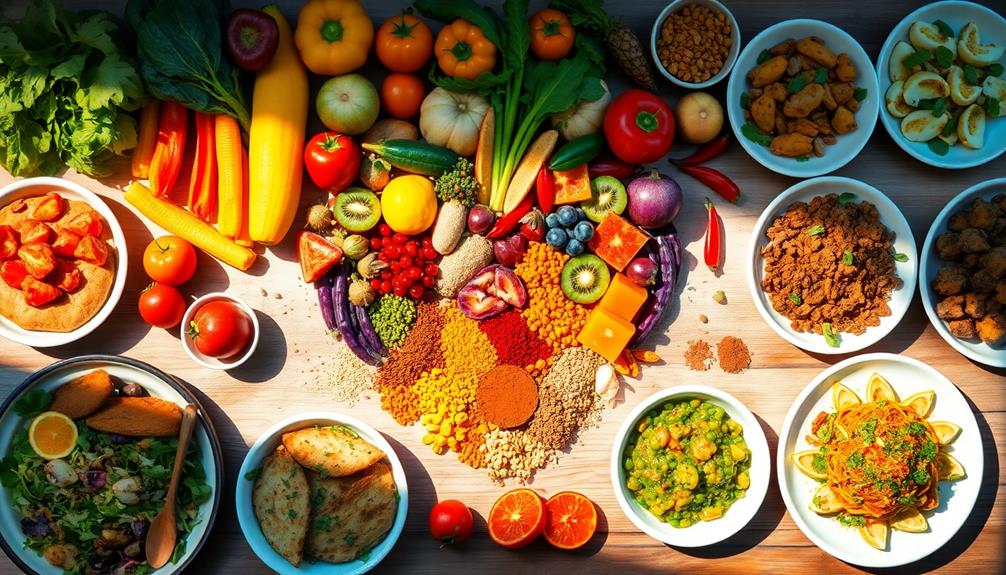
Early flavor exposure can have profound long-term health implications. Your food preferences, shaped markedly by childhood experiences, can dictate your adult diet and overall health. Here are four key aspects to reflect on:
1. Diverse Flavors: Infants exposed to a range of flavors through breastfeeding or maternal diet are more likely to embrace those flavors later, fostering a healthier relationship with food.
For instance, introducing varied tastes like Dorayaki (Red Bean Pancake) early on can encourage a love for sweet and unique flavors.
2. Picky Eating: Limited flavor exposure can lead to picky eating, restricting dietary patterns that may contribute to inadequate nutrition and poor food choices in adulthood.
3. Obesity Risk: Early dietary patterns are closely linked to obesity and chronic diseases. A varied palate during childhood often translates into healthier eating habits, reducing the risk of these health issues.
4. Essential Period: The first 1000 days of life are vital in shaping future food preferences, impacting long-term health outcomes, including risk for obesity and cardiovascular disease.
Understanding these implications highlights the importance of nurturing diverse flavor experiences, setting the stage for positive nutrition throughout life.
Strategies for Flavor Acceptance

To help your child embrace new flavors, consistently exposing them to a variety of fruits and vegetables is key.
Incorporating seasonal dishes like a Nettle and Potato Soup can introduce unique tastes while also providing nutritional benefits.
Pairing familiar tastes with new ones can make the unfamiliar more appealing and reduce pickiness.
Creating a positive eating environment through family meals and encouragement can further support their journey toward adventurous eating.
Repeated Flavor Exposure
Repeated exposure to various flavors can markedly influence children's food preferences and acceptance. When you introduce a variety of healthy foods to your little ones, it sets the stage for them to embrace new tastes.
For instance, incorporating fun and festive dishes like Graveyard Taco Dip can make the experience enjoyable while expanding their palate. Here are some strategies to enhance their flavor acceptance:
- Start Early: Introduce a range of flavors during infancy to shape their preferences positively.
- Keep it Familiar: Pair new foods with familiar ones at mealtime, which can help ease the adjustment as they learn to accept new foods.
- Be Patient: Aim for 8-10 exposures to each new flavor; this repetition is key to acceptance.
- Create a Supportive Environment: Use positive reinforcement by encouraging your child to explore and taste new foods without pressure.
Diverse Food Introductions
Introducing a variety of foods can open up a world of flavors for your child, setting the groundwork for a lifetime of healthy eating habits. By offering diverse foods during early feeding stages, you're enhancing their acceptance of different flavors. Repeated exposure, about 8-10 times, can greatly boost your child's willingness to try new tastes.
Here's a quick overview of strategies for flavor acceptance:
| Type of Food | Examples | Benefits |
|---|---|---|
| Fruits | Apples, mangoes, berries | Introduces sweetness and variety |
| Vegetables | Carrots, spinach, peas | Builds familiarity with textures |
| Whole Grains | Oats, quinoa, brown rice | Promotes healthier dietary choices |
| Proteins | Chicken, beans, tofu | Encourages adventurous eating habits |
| Dairy Alternatives | Yogurt, nut milks | Introduces new flavors and nutrients |
Maternal diets during pregnancy and breastfeeding also play a crucial role, exposing infants to diverse flavors through breast milk. Early experiences with these varied solid foods lead to broader palates and healthier food preferences in adulthood. Start early, and you'll foster a love for diverse flavors in your child.
Positive Eating Environments
Creating a positive eating environment can greatly boost your child's willingness to explore new flavors. When children feel safe and supported during meals, they're more likely to try nutritious foods and develop healthy eating behaviors.
Here are some strategies to contemplate:
- Shared meals: Sit down together as a family, making mealtime a bonding experience that encourages open conversations about food.
- Familiar flavors: Introduce new foods alongside favorites, creating a sense of security that promotes adventurous eating.
- Model behavior: Demonstrate healthy eating by enjoying nutritious foods yourself, as kids often mimic their parents' food preferences.
- Repeated exposure: Aim for at least 8 to 10 introductions of new flavors to enhance acceptance and reduce aversions.
Socioeconomic Factors in Food Choices
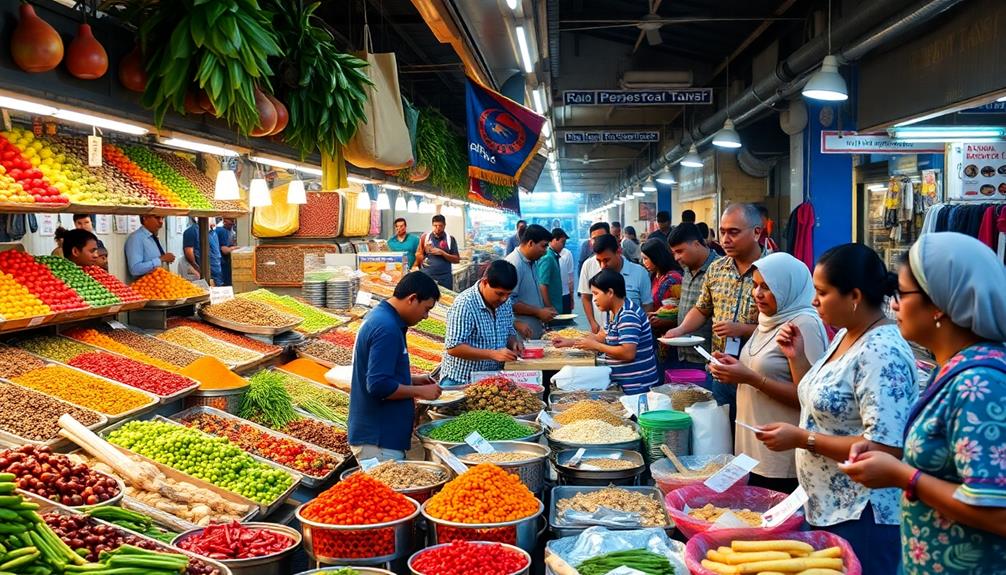
Socioeconomic factors play an essential role in shaping food choices, often dictating what families can put on their plates. Your socioeconomic status considerably influences access to diverse food options. If you're in a lower-income bracket, you might find yourself living in a food desert, where fresh, nutritious foods are hard to come by.
This lack of availability can limit flavor exposure during early development, making it harder for you to cultivate healthy food preferences later on. Economic constraints also dictate your ability to purchase healthy food options, leading to dietary habits that can perpetuate poor health outcomes.
Education level plays a vital role here, as it affects your knowledge of healthy eating. Higher education often means you can provide varied and nutritious food options for your children, which is essential for their flavor development.
Family meals can enhance food preference development, and households with a higher socioeconomic status typically have more opportunities for diverse culinary experiences. Positive reinforcement for healthy eating practices is more common in these environments, influencing children's acceptance of nutritious foods.
Ultimately, these factors shape not just immediate choices but also long-term dietary habits that persist into adulthood.
Future Research Directions

Understanding how early exposure to flavors influences food preferences opens up numerous avenues for future research.
You might consider several key areas that could greatly impact our understanding of dietary habits and adult eating patterns:
- Maternal Diet: Examining the long-term effects of a mother's diet during pregnancy and lactation on offspring flavor acceptance and dietary habits.
- Sensitive Periods: Investigating critical periods for flavor and texture acceptance in infants to identify effective dietary interventions.
- Healthier Options: Evaluating strategies that could shift children's preferences toward healthier options by enhancing their early sensory experiences.
- Socio-Cultural Contexts: Analyzing how socio-cultural factors influence food preferences established in early life and their implications on dietary habits.
Frequently Asked Questions
How Taste Preferences in Infancy Differ From Taste Preferences in Adulthood?
Infants generally prefer sweeter and umami flavors, while adults appreciate a wider range, including bitter and sour. You'll notice that children seek higher sugar concentrations and develop a more varied palate as they grow.
Do Food and Drink Preferences Change After Early Adulthood?
Yes, your food and drink preferences can definitely change after early adulthood. Life experiences, social interactions, and evolving dietary needs influence your tastes, leading you to explore new flavors and revisit nostalgic favorites over time.
At What Age Do Food Preferences Start?
Imagine a baby tasting flavors like a foodie at a gourmet restaurant. Food preferences start forming in utero, influenced by what you eat, and by age five, most of your likes and dislikes are set.
Do True or False Taste Preferences Develop at an Early Age?
True, taste preferences develop early. You start forming these preferences even before birth, influenced by what your mother eats. Your early experiences with flavors greatly shape your likes and dislikes as you grow.
Conclusion
As you reflect on how your early exposure to flavors shaped your food preferences, consider the intricate web of influences at play. What if the tastes you shunned as a child could reveal a world of culinary delight? The choices made in infancy echo through adulthood, hinting at a deeper connection between our diets and health. With each bite, you might just be rewriting your palate's story. Are you ready to embrace new flavors and discover what's been waiting for you?
-

 id5 months ago
id5 months agoPanduan Karir Internasional untuk Warga Indonesia
-

 id5 months ago
id5 months agoTemukan Keindahan Pendopo Jakarta sebagai Destinasi Anda
-

 id5 months ago
id5 months agoBerbagi Opini Anda – Wawasan untuk Indonesia
-

 id5 months ago
id5 months agoKesra Sebagai Pilihan Pangan Sehat untuk Keluarga
-

 id5 months ago
id5 months agoBerita-Terkini Indonesia: Info Terbaru Hari Ini
-

 id5 months ago
id5 months agoRahasia Sehat dengan Olahraga Rutin Anda
-

 News5 months ago
News5 months agoUnderstanding Ekonomi: Basics and Beyond
-

 News4 months ago
News4 months agoThe Heartbreaking Story of Tim Chapman's Wife



























